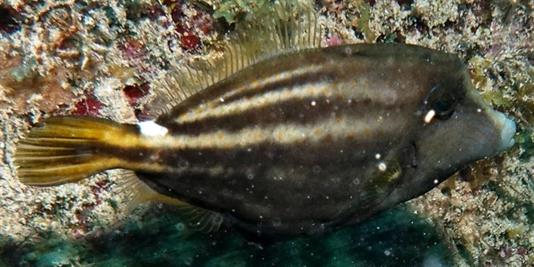



Cantherhines pullus
| Ecological Descriptors |
||||
| Habitat | Size (cm) | Diet | Behaviour | Sex |
| Co, R | 14-20 | Veg, Spo (Tun, Bry) | I | F |
Not to be confused with a Pacific species with the same common name: Oxymonacanthus longirostris
N.B:
Orange Spotted Filefish
Description:
Dark brown, deep, laterally compressed body. Head with fine orange longitudinal lines. Body with pale longitudinal stripes overlaid by yellow-orange spots. There is a prominent white spot on upper caudal peduncle. Tai rounded with radiating dark lines. First dorsal spine originating above the center or front part of the eye and followed by a deep groove into which the spine can fold - the spine cannot be locked.
Ecology
Found in shallow water and around coral and rocky reefs, down to 50m (160ft). Usually remains near the bottom, hiding among gorgonians and branching corals. Feeds on bottom growth, primarily sponges and algae. The young are pelagic and form a highly important food item in the diet of larger predaceous fishes.
Adults can be either solitary or in pairs, drifting with their head pointing downwards and floating among the seagrass to camouflage from both predators and prey. Adults are usually more active in the day and less at night and are classified as diurnal.
Life Cycle
Breed in groups usually consisting of one male and two to five females. Spawn sites are prepared by the male, located in safe areas away from sight from predators, such as a depression in the sand. The females lay eggs in these safe spawn sites which are fertilized by the male and guarded by either the male or the female. The eggs are bright green and adhesive; they stick together at a bottomand brood usually consists of about 300 eggs. The juvenile filefish are pelagic, and seek out floating sargassum for protection from predators such as tuna and dolphinfish.
Dark brown, deep, laterally compressed body. Head with fine orange longitudinal lines. Body with pale longitudinal stripes overlaid by yellow-orange spots. There is a prominent white spot on upper caudal peduncle. Tai rounded with radiating dark lines. First dorsal spine originating above the center or front part of the eye and followed by a deep groove into which the spine can fold - the spine cannot be locked.
Ecology
Found in shallow water and around coral and rocky reefs, down to 50m (160ft). Usually remains near the bottom, hiding among gorgonians and branching corals. Feeds on bottom growth, primarily sponges and algae. The young are pelagic and form a highly important food item in the diet of larger predaceous fishes.
Adults can be either solitary or in pairs, drifting with their head pointing downwards and floating among the seagrass to camouflage from both predators and prey. Adults are usually more active in the day and less at night and are classified as diurnal.
Life Cycle
Breed in groups usually consisting of one male and two to five females. Spawn sites are prepared by the male, located in safe areas away from sight from predators, such as a depression in the sand. The females lay eggs in these safe spawn sites which are fertilized by the male and guarded by either the male or the female. The eggs are bright green and adhesive; they stick together at a bottomand brood usually consists of about 300 eggs. The juvenile filefish are pelagic, and seek out floating sargassum for protection from predators such as tuna and dolphinfish.



21


